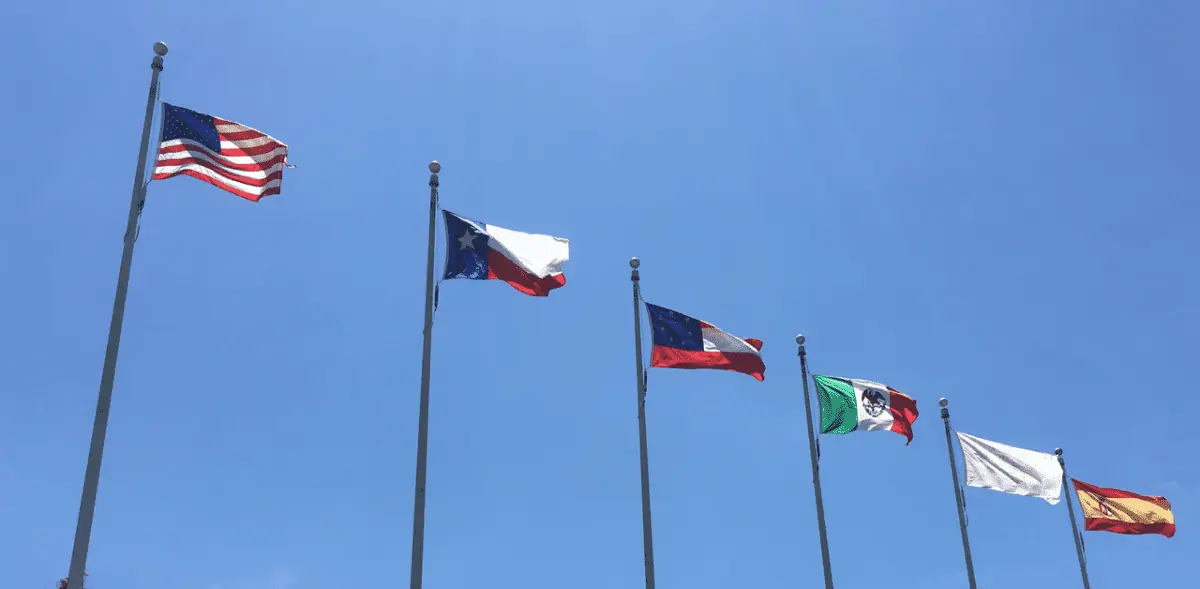When you hear “six flags of Texas,” you immediately think of the well-known amusement park. You’re not too far off! Six Flags Over Texas, located in Arlington, Texas, was named after the six governments that have claimed control throughout Texas over the years.
By chronological order, these nations are the Kingdom of Spain, the Kingdom of France, the Republic of Mexico, the Republic of Texas, the Confederate States of America, and finally the United States of America.
In this article, we’re going to take a trip down the rich history of the Lone Star state and discuss each flag that has flown over it.

Texas Under Spain (1519-1685) (1690-1821)
The Spanish were the first Europeans to set foot in Texas. However, after exploring it, they abandoned it for 160 years until the French claimed the land.
The Spanish then undertook multiple missions, both on land and water. This was done to locate the head of the French expedition, Sieur de La Salle, and terminate the French colony in Texas.
Early Spanish Exploration (1519-1685)
It all began in 1519 when Spanish explorer Alonso Alvarez de Pineda conducted an expedition for Jamaica’s governor, Francisco de Garay. He created the earliest recorded document of Texas history, a map of the Northern Gulf Coast.
Other Spanish explorers, such as Alvar Nunez and Cabeza de Vaca, were shipwrecked and later discovered and explored the land.
The Spanish Colony in Texas (1690-1821)
It took more than a century for the Spanish to establish a settlement in Texas. This is because they were more interested in gold than in Texas itself. Since Texas wasn’t famed for its riches, the Spanish claimed it but had no intention of defending or populating it.
That is, until they discovered the French presence in Texas, which we will cover later. They saw the French seizing their land as a danger to Spanish mining and shipping lines. Thus, they ordered their removal immediately.
As a result, King Carlos II’s Council of War advised the removal of “This thorn which has been thrust into the heart of America. The greater the delay, the greater the difficulty of attainment.”
Three years and ten expeditions later, the Spanish demolished the French forts and regained Texas for themselves.
Spanish Legacy
While the Spanish were exploring Texas, they encountered the Caddo people. Upon communicating with the Indian tribe, the Spanish used the Caddo word for friendship “taysha” to name the area Tejas, which is now Texas. Interestingly, this is why Texas’s motto is friendship!
The Spanish also named one of the United States’s largest cities, known as San Antonio today. As you can see, Spain left a lasting legacy that is seen in both today’s language and place names.
The Flag
The Spanish flag consisted of two lions and two castles on white and red backgrounds. The lions represent the kingdom of Leon, while the castles symbolize the kingdom of Castile.
You can typically find the Spanish flag among the other national flags on your trip to the famous Six Flags amusement park.

Texas Under France (1685-1690)
After claiming Louisiana, France made a bold move and claimed Spanish land in Eastern Texas. This plan, however, backfired completely. In 1685, French explorer Sieur de La Salle returned to the Americas with 400 people and four ships to find the Mississippi river.
The Objective
The objective was to return and establish a colony on the territories he had previously explored and claimed, namely Louisiana and the Mississippi River. However, the mission failed miserably, and La Salle and his men were lost in Matagorda Bay.
They eventually found themselves in Texas, which was Spanish territory. Even though they weren’t meant to be there, La Salle was determined to claim this territory for his king, Louis XIV.
Because the Spanish were unconcerned about Texas at the time, no one was around to warn France that this was not their country to claim. However, Spain quickly became interested in Texas after learning that France invaded it.
The Consequence
France finally built a fort called St. Louis, which Spain subsequently demolished after discovering it. Because la Salle was a cruel leader who didn’t get along with anyone, he was eventually ambushed and murdered by his people in East Texas.
By 1690, the French claim completely vanished, and Spain had reclaimed Texas once more.
The Flag
The French flag, which flew over Texas for only five years, features a white background with a cluster of golden fleur-de-lis on top.
The fleur-de-lis is commonly linked to France and may be found throughout former French territories such as Louisiana.
Texas Under Mexico (1821-1836)
Not satisfied with being ruled by a country so far away and desiring liberation, Mexico declared independence from Spain in 1821. Fearing Native American invasions and the U.S. claiming Texas, Mexico immediately sent its people to Texas and claimed it.
This arrangement was made initially with Moses Austin, an American businessman and pioneer who passed away shortly after. From there, his son, Stephen F. Austin, carried out the agreement.
Relationship Between Texas and Mexico
Texas and Mexico essentially had a good relationship, mainly because they had a lot of mutual benefits.
For example, Americans who wished to invade Texas and obtain cheap land would benefit, while Mexico also benefits from having people cultivate the land and protect it from Native American invasions.
The Texas Revolution
After Antonio López de Santa Anna was declared dictator, Texas began to have disagreements with Mexico. This is when everything began to go south.
Santa Anna was implementing rules and restrictions that led American settlers and Tejanos to rebel against Mexico. As a result, the Texas revolution began and concluded with the state’s independence in 1836.
The Flag
The Mexican flag features three vertical color stripes; green, white, and red. These colors represent the Three Guarantees. Green denotes independence, white represents the Roman Catholic church, and red represents union.
To honor Mexico’s Aztec history, an eagle stands atop a cactus with a snake in its mouth in the middle of the flag.
The Republic of Texas (1836-1845)
After defeating Santa Anna in San Jacinto, Texas became an independent nation for nine years. Throughout those nine years, the Republic of Texas had four presidents:
- David Burnet (Mar. 1836 – Oct. 1836)
- Sam Houston (Oct. 1836 – Dec. 1838)
- Mirabeau Lamar (Dec. 1838 – Dec. 1841)
- Sam Houston was re-elected (Dec. 1841 – Dec. 1844)
- Anson Jones (Dec. 1844 – Feb. 1846)
Complications Following Independence
After gaining independence, settlers spent most of their time deciding whether or not they wanted Texas to be a part of the United States. During this period, they were put through several ordeals.
Despite the presence of the Treaties of Velasco, they were still being attacked by Mexico. Furthermore, the treaties made by Sam Houston with the native Americans were not honored by the third president, Mirabeau Lamar. As a result, native Americans plundered the state regularly.
Texas was also heavily in debt and faced antagonism from a number of external sources. Texans eventually concluded that being a part of the United States is in the state’s best interest.
The Flag
If you live in Texas today, you’ve probably seen this flag a lot. This flag, which was adopted in 1839, is known today as the lone star flag. It combines the colors red, blue, and white to signify bravery, loyalty, and purity.
Texas in the Confederacy (1861-1865)
Sixteen years after Texas became part of the United States, the Civil War started (April 12, 1861 – April 9, 1865). During the civil war, Texas seceded from the union and became a member of the confederate states of America along with:
- Arkansas
- Louisiana
- Tennessee
- Mississippi
- Alabama
- Georgia
- Florida
- South Carolina
- North Carolina
- Virginia
Conclusion of the Civil War
On November 6, 1865, the confederacy was defeated and eventually surrendered. Following that, the Confederacy was disbanded, and Texas was reunited to become a member of the United States of America.
The Flag
The Confederate flag, which resembled both the Texas and the United States flags, flew until the war’s end. Although there were three flags used during the Confederacy, the “stars and bars” flag was the most recognized.
It has horizontal red and white stripes and a blue circle on the top left. Inside the circle are white stars corresponding to the number of states that had seceded from the Union.
Texas in the United States of America (1845-1861) (1865-Present)
After gaining independence from Mexico and before the civil war, Texas became the 28th state in the United States of America. It joined as a slave state, which is why it was a part of the Confederacy during the Civil War.
On March 30, 1870, Texas re-joined the union and has been a member of the U.S. ever since.
The Flag
The American flag first flew over Texas in 1845, where it remained until the present day. The well-known flag has 13 horizontal red and white stripes that represent the 13 original colonies.
It also features a navy blue square in the top left corner with 50 stars representing each of the 50 states.
References:
- The Spanish came to Texas looking for gold: https://www.thestoryoftexas.com
- La Salle was a cruel leader: https://www.historymuseum.ca/
- The Texans hated Santa Anna: https://www.news-journal.com
Christian Linden is a seasoned writer and contributor at Texas View, specializing in topics that resonate with the Texan community. With over a decade of experience in journalism, Christian brings a wealth of knowledge in local politics, culture, and lifestyle. He holds a Bachelor's degree in Communications from the University of Texas. When he's not writing, Christian enjoys spending weekends traveling across Texas with his family, exploring everything from bustling cities to serene landscapes.











